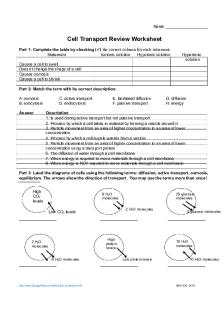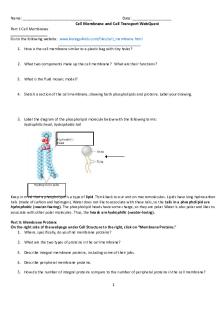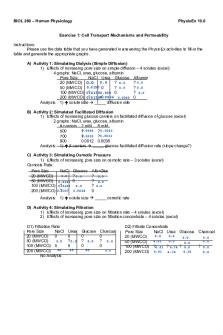Cell Transport Review Worksheets PDF

| Title | Cell Transport Review Worksheets |
|---|---|
| Author | Ka'Mira Holmes |
| Course | Wave optics |
| Institution | Capitol Technology University |
| Pages | 8 |
| File Size | 387.9 KB |
| File Type | |
| Total Downloads | 80 |
| Total Views | 176 |
Summary
Good biology work answers are included...
Description
Name: ________________________________
Block: ________
Cell Transport Review Worksheet Complete the table by checking the correct column for each statement:
Statement
Isotonic solution
Hypotonic solution
Hypertonic solution
Causes a cell to swell Doesn’t change the shape of a cell Causes osmosis Causes a cell to shrink Match the term with its correct description: a. energy b. facilitated diffusion c. endocytosis d. passive transport
e. active transport f. exocytosis g. carrier protein h. channel protein
________ Transport protein that provides a tube-like opening in the plasma membrane through which particles can diffuse ________ Is used during active transport but not passive transport ________ Process by which a cell takes in material by forming a vacuole around it ________ Particle movement from an area of higher concentration to an area of lower concentration ________ Process by which a cell expels wastes from a vacuole ________ A form of passive transport that uses transport proteins ________ Particle movement from an area of lower concentration to an area of higher concentration ________ Transport protein that changes shape when a particle binds with it Match the term with its correct description: a. transport protein d. passive transport b. active transport e. osmosis c. diffusion f. endocytosis
g. exocytosis h. equilibrium
_____ The diffusion of water through a cell membrane _____ The movement of substances through the cell membrane without the use of cellular energy _____ Used to help substances enter or exit the cell membrane _____ When energy is required to move materials through a cell membrane _____ When the molecules of one substance are spread evenly throughout another substance to become balanced
_____ A vacuole membrane fuses (becomes a part of) the cell membrane and the contents are released _____ The cell membrane forms around another substance, for example, how the amoeba gets its food _____ When molecules move from areas of high concentration to areas of low concentration Label the diagrams of cells using the following terms: diffusion, active transport, osmosis, facilitated diffusion, or equilibrium. The arrows show the direction of transport. You may use the terms more than once! High CO2 levels
8 H2 O molecules
25 glucose molecules 2 H2O molecules
Low CO2 levels
10 H2O molecules
High protein levels
2 H2 O molecules
8 H2O molecules
5 glucose molecules
Low protein levels
10 H2O molecules
Osmosis Practice Activity Osmosis is the diffusion of water from an area of high concentration to an area of low concentration. Only water moves in osmosis! The diagrams below show the concentration of water and salt inside the cell and the concentration of water and salt surrounding the cell. Complete the sentences below by comparing the concentration of the water inside the cell and the concentration outside the cell. 1. 5% NaCl 95% H2O
95% NaCl 5% H2O
a. Water will flow _____________________ (into the cell, out of the cell, in both directions). b. The cell will ______________________ (shrink, burst, stay the same).
2.
5% NaCl 95% H2O
5% NaCl 95% H2O
a. Water will flow _____________________ (into the cell, out of the cell, in both directions). b. The cell will ______________________ (shrink, burst, stay the same).
a. Water will flow _____________________ (into the cell, out of the cell, in both directions).
3. 95% NaCl 5% H2O
5% NaCl 95% H2O
b. The cell will ______________________ (shrink, burst, stay the same).
4. At which solution of concentration gradient is each cell diagram? (Hypotonic, Hypertonic, Isotonic)
a. _____________
b. ________________
c. ____________
5. This diagram is moving from a high to a low concentration: ___________________
6. Using a transport protein to move particles across the membrane: ___________________
7. Describe the processes occurring in the following pictures:
8. Define homeostasis.
9. What role does the cell membrane play in maintaining homeostasis?
10. How is facilitated diffusion different from diffusion? How are they similar?
11. List two ways that active transport is different than passive transport. 1) _________________________ 2) _________________________
12. Why is the sodium-potassium pump considered an active transport? Which direction are the sodium and potassium bing pumped? How many sodiums are being pumped? How many potassiums are being pumped?
13.
14. What are the 5 functions of the cell membrane? 1) 2) 3) 4) 5)
15. Label the Phospholipid. Include the terms: Phosphate Head, Fatty Acid Tail, Hydrophilic, Hydrophobic
16. On the front of this page, define the words in each box in your own words. Then, on the back, draw a picture of each using 4 colors. Active Transport
Semi Permeable
Cell Membrane
Diffusion
Cyclosis
Osmosis
Endocytosis
Exocytosis
Facilitated Diffusion
Homeostasis
Draw a picture of each of these vocabulary terms using at least 4 colors.
Active Transport
Semi Permeable
Cell Membrane
Diffusion
Cyclosis
Osmosis
Endocytosis
Exocytosis
Facilitated Diffusion
Homeostasis...
Similar Free PDFs

Cell Transport Review Worksheets
- 8 Pages

4- Cell Transport Review
- 4 Pages

Cell Transport Activity
- 3 Pages

Cell Transport Lab Report
- 2 Pages

Cellular Transport Review 21
- 6 Pages
Popular Institutions
- Tinajero National High School - Annex
- Politeknik Caltex Riau
- Yokohama City University
- SGT University
- University of Al-Qadisiyah
- Divine Word College of Vigan
- Techniek College Rotterdam
- Universidade de Santiago
- Universiti Teknologi MARA Cawangan Johor Kampus Pasir Gudang
- Poltekkes Kemenkes Yogyakarta
- Baguio City National High School
- Colegio san marcos
- preparatoria uno
- Centro de Bachillerato Tecnológico Industrial y de Servicios No. 107
- Dalian Maritime University
- Quang Trung Secondary School
- Colegio Tecnológico en Informática
- Corporación Regional de Educación Superior
- Grupo CEDVA
- Dar Al Uloom University
- Centro de Estudios Preuniversitarios de la Universidad Nacional de Ingeniería
- 上智大学
- Aakash International School, Nuna Majara
- San Felipe Neri Catholic School
- Kang Chiao International School - New Taipei City
- Misamis Occidental National High School
- Institución Educativa Escuela Normal Juan Ladrilleros
- Kolehiyo ng Pantukan
- Batanes State College
- Instituto Continental
- Sekolah Menengah Kejuruan Kesehatan Kaltara (Tarakan)
- Colegio de La Inmaculada Concepcion - Cebu










